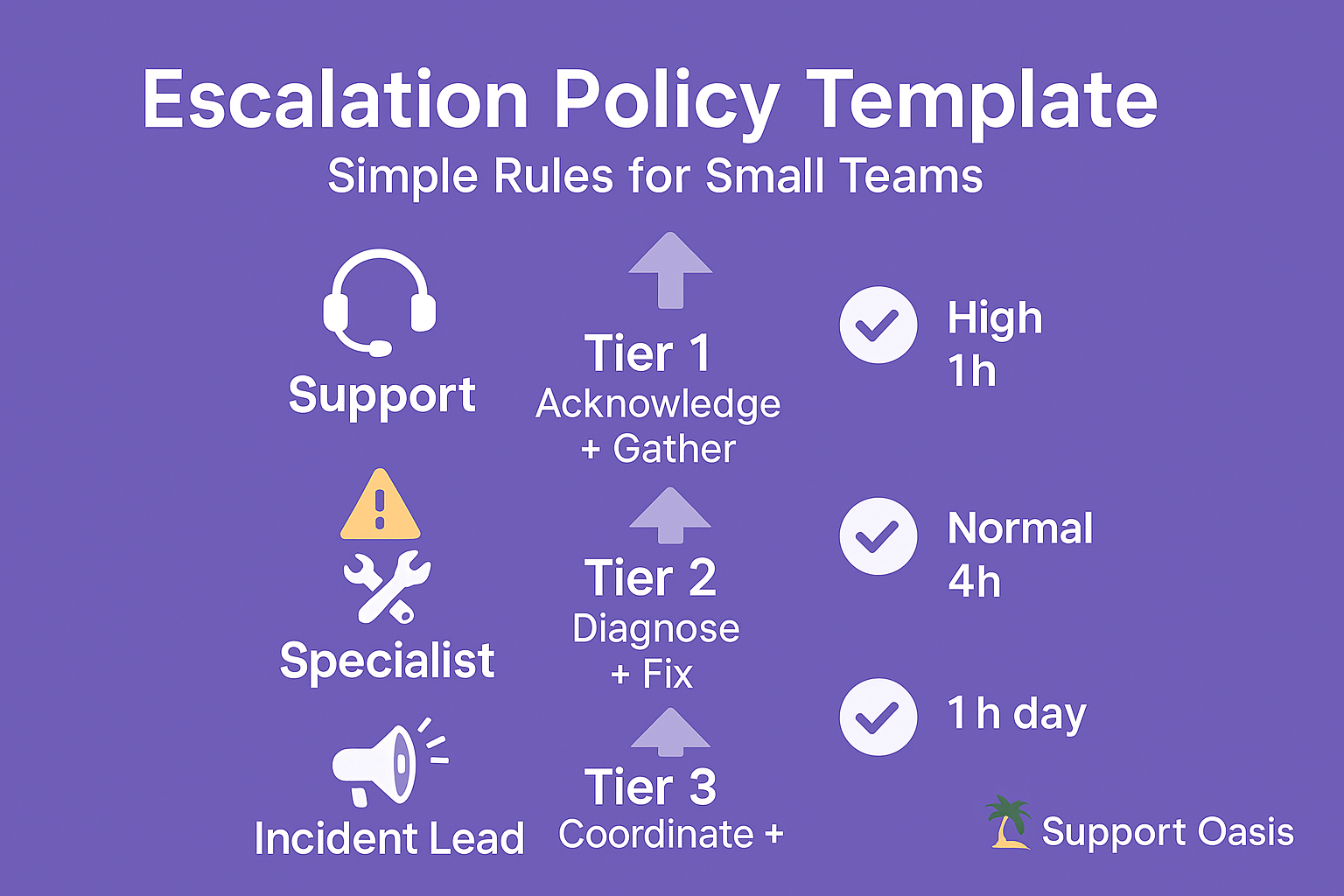An escalation policy template gives small teams a clear path for urgent tickets. As a result, issues move to the right person quickly, customers get faster updates, and your SLAs stay on track. In addition, a simple template keeps training easy as your team grows.
Escalation Policy Template: What to Include
Your policy should define ownership, time targets, and handoffs. Therefore, include the following building blocks:
- Tiers and roles with specific responsibilities.
- Response and resolution targets by priority.
- After-hours rules and on-call coverage.
- Status updates and customer communication steps.
For setup basics, see How to Set Up a Helpdesk for Your Small Team in One Day and the comparison in Shared Inbox vs Helpdesk: Which Is Better for Small Teams?. Research from Harvard Business Review shows that clear and timely communication improves customer loyalty, which strong escalation rules support.
Escalation Tiers and Roles
Tier 1: Frontline support
First, acknowledge the ticket, gather details, and apply saved replies where helpful. If the issue blocks the customer or repeats across users, escalate. For tone and speed, review Email-Based Helpdesk: Simple Setup for Small Teams.
Tier 2: Specialist or engineer
Next, reproduce the issue, document findings, and propose a fix or workaround. If risk or impact is high, notify Tier 3. Meanwhile, keep Tier 1 informed so updates reach the customer.
Tier 3: incident lead or founder
Finally, coordinate cross-team response, set public status updates, and decide on customer credits if needed. After resolution, schedule a brief review so lessons turn into playbook updates.
Time Targets and SLAs
Set targets you can hit now, then raise them later:
- High priority: first reply within 1 hour, resolution same day.
- Normal priority: first reply within 4 hours, resolution within 1 business day.
Because targets guide behavior, publish them in onboarding and revisit monthly. For broader context on right-sized tools, see Helpdesk Software Without the Bloat: Tools Built for Lean Teams.
On-Call and Handoffs
Define who is on-call after hours and how to reach them. In addition, document handoffs at shift change, including current status, next action, and deadline. Consequently, work keeps moving even when the original agent signs off.
After-hours escalation policy template
- If priority is High after business hours, page the on-call owner.
- If priority is Normal, queue for the morning and send an acknowledgment.
- If the issue affects multiple users, notify Tier 3 immediately and post a status update.
- If the fix needs production access, require Tier 2 approval before deploy.
Copy-Ready Escalation Policy Template
Purpose: Ensure urgent tickets reach the right owner with clear timelines.
Scope: All support tickets created in the helpdesk.
Tiers and owners
- Tier 1: Frontline support. Acknowledge, collect details, apply saved replies, and resolve simple issues.
- Tier 2: Specialist or engineer. Reproduce, diagnose, and implement fixes or workarounds.
- Tier 3: Incident lead. Coordinate response, communicate broadly, and approve customer credits.
Priorities and targets
- High: first reply 1 hour, resolution same day.
- Normal: first reply 4 hours, resolution 1 business day.
Escalation rules
- Escalate from Tier 1 to Tier 2 when blocked, high impact, or repeated.
- Escalate to Tier 3 when risk is high, customers are widely affected, or SLAs are at risk.
- During handoff, include status, next action, owner, and deadline.
Communication
- Send acknowledgments with the next update time.
- Post updates after material changes or every four hours for High priority.
- Close with a brief summary and prevention note.
Common Mistakes and Quick Fixes
- Too many tiers for a small team. Instead, start with three.
- Vague time targets. Therefore, write exact numbers and stick to them.
- Missing pager or contact method. In addition, add a single on-call channel.
- No review after incidents. As a result, the same problems return.
Final Thoughts
A clear escalation policy template keeps work moving, even when volume spikes. In conclusion, define tiers, set targets, document handoffs, and review incidents regularly. As a result, small teams stay fast without adding complexity.
Ready to handle escalations with clarity?
Try Support Oasis for free to launch email ticketing, SLAs, and simple escalation rules in minutes. Try for free or learn more about Support Oasis.
